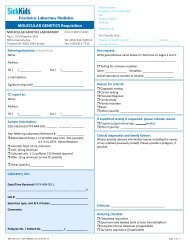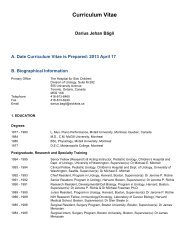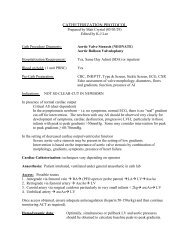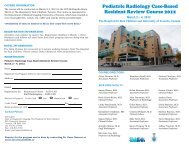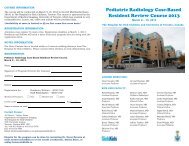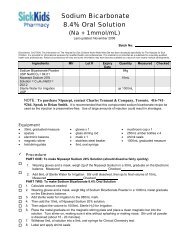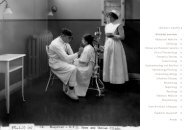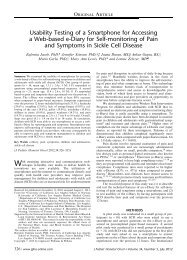Management of Bronchiolitis in Infants - The Hospital for Sick Children
Management of Bronchiolitis in Infants - The Hospital for Sick Children
Management of Bronchiolitis in Infants - The Hospital for Sick Children
You also want an ePaper? Increase the reach of your titles
YUMPU automatically turns print PDFs into web optimized ePapers that Google loves.
<strong>The</strong> <strong>Hospital</strong> <strong>for</strong> <strong>Sick</strong> <strong>Children</strong> Policies & Procedures Database<br />
Table 3. <strong>Bronchiolitis</strong> Discharge Criteria Checklist<br />
respiratory status is consistently improv<strong>in</strong>g<br />
Respiratory Status<br />
tachypnea and <strong>in</strong>creased work <strong>of</strong> breath<strong>in</strong>g are normal, mild or<br />
moderate<br />
oxygen saturation is <strong>in</strong> an acceptable range on room air (greater<br />
than 88% when sleep<strong>in</strong>g and greater than 90% when awake)<br />
Nutritional Status the patient is on oral feed<strong>in</strong>gs sufficient to prevent dehydration<br />
Parent & Family Education<br />
Social<br />
Follow-up<br />
nature <strong>of</strong> illness and expected cl<strong>in</strong>ical course <strong>of</strong> bronchiolitis<br />
to call their primary care provider or return to the ED when the<br />
follow<strong>in</strong>g signs <strong>of</strong> worsen<strong>in</strong>g cl<strong>in</strong>ical status are observed (Parent<br />
friendly language <strong>in</strong> parentheses)<br />
<strong>in</strong>creas<strong>in</strong>g respiratory rate and/or work <strong>of</strong> breath<strong>in</strong>g as<br />
<strong>in</strong>dicated by accessory muscle use<br />
(i.e. breath<strong>in</strong>g very fast and/or sk<strong>in</strong> suck<strong>in</strong>g <strong>in</strong> around the neck or ribs<br />
with each breath)<br />
<strong>in</strong>ability to ma<strong>in</strong>ta<strong>in</strong> adequate hydration<br />
(i.e. unable to feed or dr<strong>in</strong>k by mouth or has not had a wet diaper <strong>in</strong><br />
more than 6 to 8 hours)<br />
worsen<strong>in</strong>g general appearance<br />
(has new symptoms not present while <strong>in</strong> the hospital such as vomit<strong>in</strong>g<br />
or fever, looks lethargic or does not respond normally to touch or<br />
sound, change <strong>in</strong> baby's colour)<br />
importance <strong>of</strong> handwash<strong>in</strong>g be<strong>for</strong>e and after contact with the child<br />
to prevent spread <strong>of</strong> disease. 1[A]<br />
elim<strong>in</strong>at<strong>in</strong>g exposure to environmental smok<strong>in</strong>g. 1[A]<br />
limit<strong>in</strong>g exposure to contagious sett<strong>in</strong>gs and sibl<strong>in</strong>gs<br />
provide a general <strong>in</strong><strong>for</strong>mation pr<strong>in</strong>tout See ==> About Kids Health –<br />
<strong>Bronchiolitis</strong> Fact Sheet <strong>for</strong> parents<br />
language skills to understand discharge <strong>in</strong>structions<br />
parent or guardian is competent and confident they can provide<br />
care at home<br />
parents have purchased and demonstrated correct use <strong>of</strong> bulb<br />
suction<br />
<strong>in</strong>structions <strong>of</strong> when to follow-up with own primary care provider<br />
(generally 1-2 days)<br />
<strong>Management</strong> <strong>of</strong> <strong>Bronchiolitis</strong> <strong>in</strong> <strong>Infants</strong> 4



